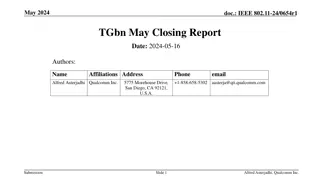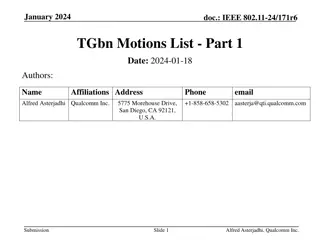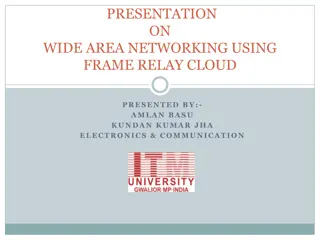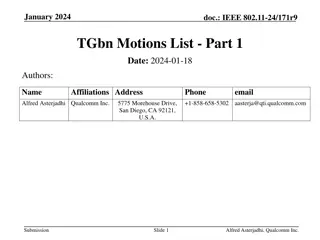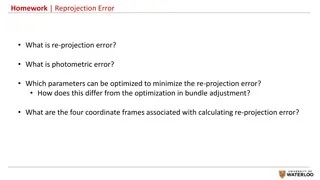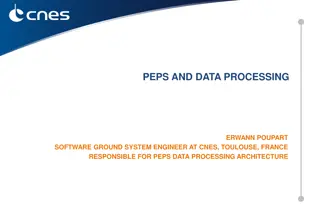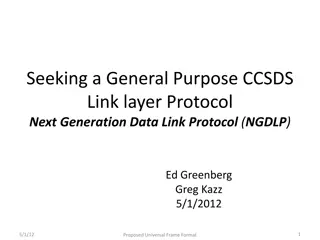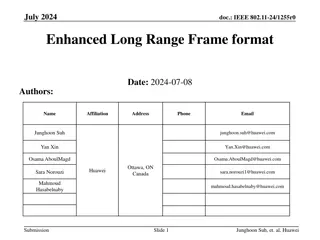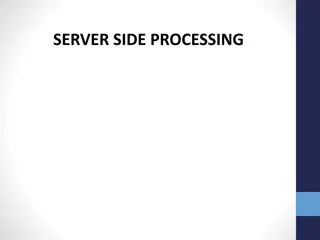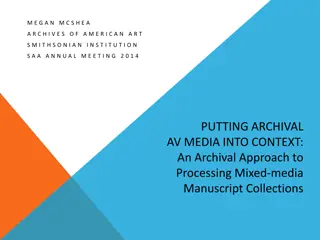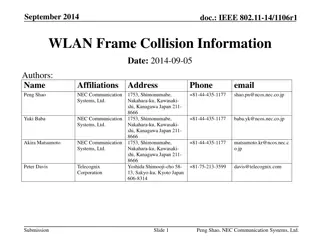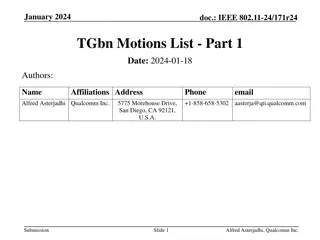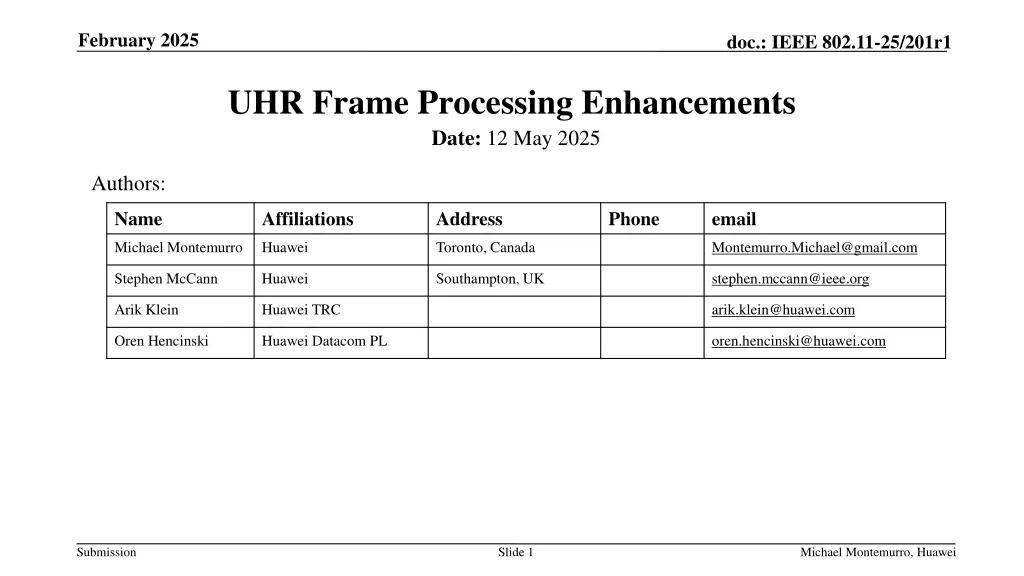
IEEE 802.11-25/201r1 UHR Frame Processing Enhancements in WLAN Technology
Explore the advancements in WLAN technology with the IEEE 802.11-25/201r1 submission focusing on enhancing frame processing for improved connectivity and seamless mobility. Learn about multi-link operation, non-AP MLD communication, MLO processing, and addressing key issues related to non-collocated multi-link operation. Discover how these enhancements pave the way for high reliability traffic delivery, seamless roaming, and more efficient data connectivity in wireless networks.
Download Presentation

Please find below an Image/Link to download the presentation.
The content on the website is provided AS IS for your information and personal use only. It may not be sold, licensed, or shared on other websites without obtaining consent from the author. If you encounter any issues during the download, it is possible that the publisher has removed the file from their server.
You are allowed to download the files provided on this website for personal or commercial use, subject to the condition that they are used lawfully. All files are the property of their respective owners.
The content on the website is provided AS IS for your information and personal use only. It may not be sold, licensed, or shared on other websites without obtaining consent from the author.
E N D
Presentation Transcript
February 2025 doc.: IEEE 802.11-25/201r1 UHR Frame Processing Enhancements Date: 12 May 2025 Authors: Name Affiliations Address Phone email Michael Montemurro Huawei Toronto, Canada Montemurro.Michael@gmail.com Stephen McCann Huawei Southampton, UK stephen.mccann@ieee.org Arik Klein Huawei TRC arik.klein@huawei.com Oren Hencinski Huawei Datacom PL oren.hencinski@huawei.com Submission Slide 1 Michael Montemurro, Huawei
February 2025 doc.: IEEE 802.11-25/201r1 Motivation One of the key advantages of WLAN technology is that STAs are mobile and can maintain connectivity with the network as they move through coverage. 11be multi-link operation (MLO) introduces the ability for a non-AP MLD to re-configure links with its associated AP MLD, while maintaining its association. If we can extend ML Reconfiguration beyond the single AP MLD, a non- AP MLD could seamlessly roam through the AP MLD coverage without ever losing data connectivity. A non-AP MLD could be configured to communicate with links to affiliated APs on different AP MLDs simultaneously (with a centralized framework). Submission Slide 2 Michael Montemurro, Huawei
February 2025 doc.: IEEE 802.11-25/201r1 Scope Previously submission 11-24/778 discussed issues related to non-collocated multi-link operation, including: Block-ACK operation The need for synchronization when traffic is transmitted on multiple links simultaneously A need for an interface between the Non-collocated (NC) MLD upper MAC Layer and the affiliated AP lower MAC layer The submission also mentioned the following key use cases: The need for high reliability traffic delivery Seamless roaming with no data loss The ability to relay traffic through another affiliated STA The contribution seeks to address these issues and builds on the NC MLO SMD Architecture presented in 11-24/2072 and the consensus on seamless mobility from motions #279 and #280. Submission Slide 3 Michael Montemurro, Huawei
February 2025 doc.: IEEE 802.11-25/201r1 Example UHR non-AP MLD communication The UHR non-AP MLD associates to the SMD ME and communicates through an AP MLD that is a member of the SMD-ME. The AP MLD can provide connectivity to non-UHR non-AP MLDs and non-AP STAs. Submission Slide 4 Michael Montemurro, Huawei
February 2025 doc.: IEEE 802.11-25/201r1 Current MLO processing For WLAN (on the downlink), MSDUs are received from the DS, processed into MPDUs and then transmitted as PPDUs. MSDUs can be fragmented into multiple MPDUs Sequence Counters and Duplicate Detection caches are assigned to MSDUs Cryptographic encapsulation is performed on MPDUs Packet numbers are assigned to MPDUs For MLO, when cryptographic encapsulation is done at the MLD, both the Sequence Counter and the PN need to be assigned at the MLD. ALL PROCESSING IS DONE BY THE MLD What about performing cryptographic encapsulation and assigning a PN to an MSDU before the Sequence Counter is assigned? Submission Slide 5 Michael Montemurro, Huawei
February 2025 doc.: IEEE 802.11-25/201r1 PN before SN For MLO, cryptographic encapsulation needs to be done at the MLD, since the Security Association is at the MLD. NOTE: For simplicity, MSDU below refers to an MSDU, A-MSDU, or MMPDU So process the frames as follows (downlink as an example): At the MLD: An MSDU is received from the DS The MSDU is assigned a PN and cryptographically encapsulated. The MSDU is distributed to an affiliated AP for further processing and transmission. At the affiliated STA, The MSDU is delivered from the NC MLD The MSDU is assigned an SN The MSDU is processed to create one or more MPDUs The affiliated STA converts the MPDUs to PPDUs and transmits them on the medium. Submission Slide 6 Michael Montemurro, Huawei
February 2025 doc.: IEEE 802.11-25/201r1 This sounds radical, but really it isn t. With this new processing: The processing at the MLD involves assigning a PN and encrypting frames. The header for an encrypted frame is already designed. The processing of the MPDUs in the affiliated STA does not involve encryption/decryption since the MSDUs are encrypted at the MLD level. The only difference is that the encryption header is present in the frame. The receiving MLD will have to perform any re- ordering, if necessary and replay detection using the PN (note that with a BA agreement, when retries occur, a similar re-ordering exercise needs to be done). Note that reordering would only occur for MSDUs received across MLDs. The new processing mechanism would be negotiated: By specifying a new cipher suite By specifying new capabilities. Michael Montemurro, Huawei Submission Slide 7
February 2025 doc.: IEEE 802.11-25/201r1 Acknowledgement, Duplicate Detection and Re-ordering Acknowledgement and BA scoreboarding are handled at each affiliated STA. The affiliated STA transmitter performs all BA operation and retransmissions if necessary. The affiliated STA receiver performs all BA operation, acknowledgment, BA scoreboarding, duplicate detection, and any re-ordering required based on SN and MPDU retransmissions. Replay detection and re-ordering across links are handled by the MLD The MLD assigns a PN to the MSDU, A-MSDU, or MMPDU and distributes them to an affiliated STA(s) for transmission. The receiving MLD processes the PN of the MSDU, A-MSDU, or MMPDU received from an affiliated STA to perform replay detection, and re-ordering if necessary If a TID is mapped to multiple links, the MSDU, A-MSDU, or MMPDU could be received out of order. The receiving MLD maintains a window for each replay counter and re-orders MSDU, A- MSDU, or MMPDUs that arrive within that window according to the PN, for a given TID. Submission Slide 8 Michael Montemurro, Huawei
February 2025 doc.: IEEE 802.11-25/201r1 Example Frame Processing at the MLD MSDU Flow - Transmitting MSDU Flow - Receiving IEEE 802.1X port filtering RX/TX MSDU rate limiting A-MSDU Aggregation/Deaggregation (null) PS Deferred Queuing for MSDU, A-MSDU, or MMPDU SYNRA Receive Filtering PN Assignment MSDU, A-MSDU, or MMPDU Encryption (TX) / Decryption (RX) (individually addressed only) (null) MSDU, A-MSDU, or MMPDU Reordering /Duplicate Detection by PN Affiliated STA encrypted MSDU, A-MSDU, or MMPDU distribution / PN Sync messaging Affiliated STA MSDU, A-MSDU, or MMPDU reception / PN Sync messaging To/From Affiliated STA NOTE: Modified frame processing steps indicated in bold. 9 Submission Michael Montemurro, Huawei Slide 9
February 2025 doc.: IEEE 802.11-25/201r1 Example Frame Processing at the Affiliated STA To/From MLD MSDU Flow - Transmitting MLD encrypted MSDU, A-MSDU, or MMPDU reception / PN Sync messaging MLD encrypted MSDU, A-MSDU, or MMPDU distribution/ PN Sync messaging MSDU Flow - Receiving RX and TX addresses to MPDU header RX and TX address to MLD address swap Block ACK buffering and reordering Sequence Number (SN) Assignment MSDU, A-MSDU, or MMPDU Encryption (TX) / Decryption (RX) (only for group addressed MSDU payload) Fragmentation (TX) / Defragmentation (RX) (null) Block ACK scoreboarding (null) Address 1 address filtering MPDU Header + CRC Creation (TX) / Validation (RX) A-MPDU Aggregation (TX) / Deaggregation (RX) NOTE: Modified frame processing steps indicated in bold. 10 Submission Slide 10 Michael Montemurro, Huawei
February 2025 doc.: IEEE 802.11-25/201r1 Summary Perform cryptographic encapsulation and assign a PN to an MSDU, A- MSDU, or MMPDU before the Sequence Counter is assigned. BA agreements can now be done on a link by link basis (i.e. a 160 MHz link does not have to use the same BA agreement as a 40 MHz link) Fragmentation and reassembly can be applied on a link by link basis. Note that some of these benefits apply to both MLO and MLO Submission Slide 11 Michael Montemurro, Huawei
February 2025 doc.: IEEE 802.11-25/201r1 PN Management and reordering If an MLD is receiving frames that are duplicated across multiple links or interleaved on multiple links, it may have to re-order the received frames prior to performing replay detection. This is distinctly different from score-boarding and (block) acknowledgment procedures. Per-link reordering is still performed, based on the SN values. In the baseline, clause 10.25.6.6.2 states Gaps may exist in the Sequence Number subfield values of the MSDUs or A-MSDUs that are passed up to the next MAC process When frames are received from a single link/affiliated AP, no further PN-based re-ordering is required. When duplicate frames are received from multiple links, duplicates need to be discarded (based on their PN values, per TID) prior to replay detection. When frames are received interleaved from multiple links, the MLD may have to re-order frames according to the PN value, per TID, prior to replay detection. Slide 12 Submission Michael Montemurro, Huawei


